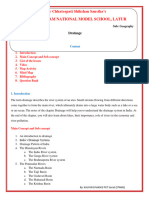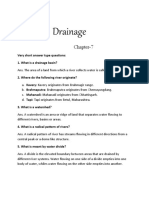Geo
Geo
Uploaded by
shivshankaraman1234Copyright:
Available Formats
Geo
Geo
Uploaded by
shivshankaraman1234Copyright
Available Formats
Share this document
Did you find this document useful?
Is this content inappropriate?
Copyright:
Available Formats
Geo
Geo
Uploaded by
shivshankaraman1234Copyright:
Available Formats
Q1: Define the Following Terms:
1. Drainage:
o Describes the river system of an area.
o Includes small streams that merge to form a main river.
o The main river drains into a large water body such as a lake, sea, or ocean.
2. Drainage Basin:
o The area drained by a single river system.
o It collects water from its tributaries and channels it to a central outlet.
3. Water Divide:
o An elevated region, like a mountain or upland, separating two drainage basins.
o Ensures water flows into different basins on either side of the divide.
Q2: Distinguish Between Himalayan and Peninsular Rivers:
1. Himalayan Rivers:
o They are perennial and have water throughout the year, fed by rain and snow.
o Long courses from their source to the sea.
o Perform significant erosion in their upper courses and deposit sediments in their
lower courses.
o Form features like gorges, meanders, oxbow lakes, and deltas.
o Examples: Indus, Ganga, and Brahmaputra.
2. Peninsular Rivers:
o Seasonal rivers, dependent on rainfall.
o Shorter and shallower courses compared to Himalayan rivers.
o Flow primarily eastward and drain into the Bay of Bengal, with few exceptions
like Narmada and Tapi flowing west.
o Form estuaries instead of deltas.
o Examples: Godavari, Krishna, and Kaveri.
Q3: Discuss the Course of the Indus River System:
1. Originates in Tibet, near Lake Mansarowar.
2. Flows westwards and enters India in the Ladakh region, forming picturesque gorges.
3. Receives tributaries such as Zaskar, Nubra, Shyok, and Hunza in Kashmir.
4. Passes through Baltistan and Gilgit, emerging from the mountains at Attock.
5. Major tributaries like Jhelum, Chenab, Ravi, Beas, and Satluj join in Pakistan near
Mithankot.
6. Flows southwards, reaching the Arabian Sea east of Karachi.
7. Total length: 2900 km, with about a third of its basin in India.
Q4: Discuss the Ganga River System:
1. The Ganga originates as Bhagirathi, fed by the Gangotri Glacier, and meets Alaknanda
at Devaprayag.
2. Emerges from the Himalayas onto the plains at Haridwar.
3. Major Himalayan tributaries: Yamuna (from Yamunotri Glacier), Ghaghara, Gandak,
and Kosi.
4. Peninsular tributaries: Chambal, Betwa, and Son, which are shorter and carry less
water.
5. At Farakka, West Bengal, the river bifurcates:
o Bhagirathi-Hooghly flows into the Bay of Bengal.
o Mainstream joins the Brahmaputra and flows into Bangladesh as the Meghna.
6. Forms the Sundarban Delta, the largest delta in the world.
7. Total length: Over 2500 km, with a gentle slope causing large meanders.
Q5: Explain the Course Taken by the Brahmaputra River in India:
1. Originates in Tibet near Mansarowar Lake and is called Tsang Po.
2. Flows eastward parallel to the Himalayas, taking a U-turn at Namcha Barwa.
3. Enters India in Arunachal Pradesh through a gorge, called Dihang.
4. Joined by tributaries like Dibang and Lohit to form the Brahmaputra in Assam.
5. Develops a braided channel and forms riverine islands, including Majuli, the largest
such island.
6. Frequently floods in Assam due to high rainfall and silt deposits.
7. Flows into Bangladesh as the Jamuna.
Q6: Why Doesn’t the Brahmaputra Create a Plain in Tibet?
The Brahmaputra River, known as Tsang Po in Tibet, flows through a cold and dry region
with minimal rainfall. This results in a smaller volume of water and less silt carried by the
river in this part of its course. Consequently, the lack of erosional and depositional activity
prevents the formation of plains in the Tibetan region
Q7: Discuss the Types of Lakes Formed in India (In Points).
1. Glacial Lakes: Found in the Himalayan region, created by glacial activity (e.g., Dal
Lake, Wular Lake).
2. Tectonic Lakes: Formed due to tectonic movements (e.g., Wular Lake).
3. Oxbow Lakes: Formed when meandering rivers cut off sections of their channels in
floodplains.
4. Lagoons: Coastal lakes formed by the action of spits and bars (e.g., Chilika Lake,
Pulicat Lake).
5. Seasonal Lakes: Appear during the rainy season in semi-arid regions (e.g., Sambhar
Lake, a saltwater lake).
6. Artificial Lakes: Created by damming rivers for hydropower and irrigation (e.g.,
Gobind Sagar).
Q8: Elaborate on the Role Played by Lakes in the Development of a
Country.
Lakes regulate river flow by storing excess water during heavy rains and preventing floods.
They ensure a consistent water supply during dry seasons and contribute to hydroelectric
power generation. Lakes also support aquatic ecosystems, maintain biodiversity, and
moderate the surrounding climate. Additionally, they enhance the natural beauty of an area,
promoting tourism and recreational activities such as boating and swimming. These benefits
collectively aid in economic and social development.
Q9: Discuss the Role Played by Rivers in the Upliftment of the Economy.
Rivers are essential for economic growth as they provide freshwater for drinking, agriculture,
and industries. They support irrigation systems crucial for farming, which is the backbone of
India’s economy. Rivers facilitate inland navigation, reducing transportation costs for goods.
They are also a source of hydroelectric power, ensuring renewable energy production.
Settlements and cities have developed along riverbanks, showcasing the central role rivers
play in economic and urban development.
Q10: The Reasons for Water Pollution Are Numerous. Discuss.
Water pollution is caused by several factors, including untreated sewage and industrial
effluents being discharged into rivers. Agricultural runoff containing fertilizers and
pesticides adds to the contamination. Over-extraction of river water reduces its ability to
dilute pollutants. Urbanization and unregulated construction along riverbanks worsen the
situation by contributing debris and waste. Cultural and religious practices, such as idol
immersion, further degrade water quality. Together, these factors significantly impact
ecosystems and human health.
Q11: What Are the Steps Taken by the Government to Control Pollution in
the Ganga River?
The government launched the Ganga Action Plan in 1985 to reduce pollution and conserve
the river. This was expanded under the National River Conservation Plan (NRCP) in 1995
to improve the water quality of other rivers.
In 2014, the Namami Gange Programme was introduced as a flagship mission to
rejuvenate the Ganga. It focuses on pollution reduction, biodiversity conservation, and
sewage treatment. Sewage treatment plants have been established to manage urban waste,
and public awareness campaigns have been initiated to involve communities in protecting
the river.
You might also like
- Ix, Drainage NotesDocument5 pagesIx, Drainage NotesShailly SinghNo ratings yet
- Geography-Chaper-3Document5 pagesGeography-Chaper-3anisha.uj1810No ratings yet
- Water Divide. It Is Often Said Water ShedDocument7 pagesWater Divide. It Is Often Said Water ShedSaksham DwivediNo ratings yet
- Drainage (1)Document4 pagesDrainage (1)Neha Sharma SagarNo ratings yet
- CBSE Chapter 3 Drainage Class 9 Important Questions and Answers PDFDocument13 pagesCBSE Chapter 3 Drainage Class 9 Important Questions and Answers PDFharshanmp123No ratings yet
- DrainageDocument4 pagesDrainagekavya sethiaNo ratings yet
- Drainage-Chapter - 3-GeographyDocument6 pagesDrainage-Chapter - 3-GeographyAryaman ParidaNo ratings yet
- DrainageDocument5 pagesDrainagemendoncapriya3No ratings yet
- G 3. Study Material DRAINAGEDocument5 pagesG 3. Study Material DRAINAGEaliya122009No ratings yet
- Indian School Sohar Lesson - 3 (Drainage) : B. Trellis Drainage PatternDocument2 pagesIndian School Sohar Lesson - 3 (Drainage) : B. Trellis Drainage PatternVr MageshNo ratings yet
- L-3 DrainageDocument4 pagesL-3 Drainagevandana13072003No ratings yet
- IX Geography Ch3Document9 pagesIX Geography Ch3Dhwni AroraNo ratings yet
- DrainageDocument19 pagesDrainageaswathyschoolworksNo ratings yet
- CH - 3 DrainageDocument3 pagesCH - 3 DrainageVeena VermaNo ratings yet
- DrainageDocument7 pagesDrainageromir.maheshwariNo ratings yet
- DrainageDocument55 pagesDrainagejejeram nagargojeNo ratings yet
- Ch 3 Reference WorksheetDocument2 pagesCh 3 Reference Worksheettanishadas.leoNo ratings yet
- Drainage Notes Geo Class9 Term1Document10 pagesDrainage Notes Geo Class9 Term1vinod157767% (3)
- 1ad7842547764576b71f79cae5fc0344Document5 pages1ad7842547764576b71f79cae5fc0344Kanav WallechaNo ratings yet
- CBSE Notes Class 9 Social Science Geography Chapter 3 - DrainageDocument4 pagesCBSE Notes Class 9 Social Science Geography Chapter 3 - DrainageHarish Lunge50% (4)
- HHDocument3 pagesHHharshanmp123No ratings yet
- SS notes drainageDocument3 pagesSS notes drainagevigneshodNo ratings yet
- 9 Drainage Questions and AnswersDocument5 pages9 Drainage Questions and AnswersSanvi SinghNo ratings yet
- Chapter - 3 DrainageDocument7 pagesChapter - 3 DrainageNovaNo ratings yet
- Geography Chapter 3 - DrainageDocument5 pagesGeography Chapter 3 - Drainageshanmugarajganesan1978No ratings yet
- Drainage notesDocument4 pagesDrainage notestanishadas.leoNo ratings yet
- Drainage ss notes-newDocument6 pagesDrainage ss notes-newvadapallibhuvan1No ratings yet
- 9 Drainage System in IndiaSCRIPT200304050503033232Document6 pages9 Drainage System in IndiaSCRIPT200304050503033232Shweta YadavNo ratings yet
- Drainage Class-9thDocument4 pagesDrainage Class-9thfeltrax69No ratings yet
- Chapter NotesDocument8 pagesChapter NotesgeeksforgeekseducationNo ratings yet
- Class 9 Geography Gist of The Lesson Taught: Chapter 3 DrainageDocument7 pagesClass 9 Geography Gist of The Lesson Taught: Chapter 3 DrainageMadhusudan BanerjeeNo ratings yet
- Drainage Class 9Document8 pagesDrainage Class 9aadyakarjeeNo ratings yet
- Drainage (NOTES, GRADE 9 CBSE CURRICULUM)Document13 pagesDrainage (NOTES, GRADE 9 CBSE CURRICULUM)humankindislostNo ratings yet
- DRAINAGEDocument2 pagesDRAINAGESuryapratap SinghNo ratings yet
- Chapter - 3 Geography Class 9thDocument10 pagesChapter - 3 Geography Class 9thDevendra Singh100% (1)
- Drainage NotesDocument6 pagesDrainage NotesAdithya VinodNo ratings yet
- 9th CBSE- DRAINAGE AARAV VISION BEYONDDocument7 pages9th CBSE- DRAINAGE AARAV VISION BEYONDanshikakumari29509No ratings yet
- DRAINAGEDocument4 pagesDRAINAGERitvik GoyalNo ratings yet
- Resource 20230817225041 Checked 9.geo.3.notesDocument6 pagesResource 20230817225041 Checked 9.geo.3.notesraeshel.g21No ratings yet
- Class Ix Geography Gist of The Lessons Taught: Chapter 3 DrainageDocument7 pagesClass Ix Geography Gist of The Lessons Taught: Chapter 3 DrainageMadhusudan BanerjeeNo ratings yet
- 9th (Geo) Ls-3 Notes Drainage of IndiaDocument6 pages9th (Geo) Ls-3 Notes Drainage of Indiassingh31367No ratings yet
- DrainageDocument8 pagesDrainagefrisbbe.10No ratings yet
- drainageDocument9 pagesdrainagepurple.bless74No ratings yet
- drainageDocument6 pagesdrainagebd6311427No ratings yet
- Class Ix Geography Gist of The Lesson Taught: Chapter 3 DrainageDocument7 pagesClass Ix Geography Gist of The Lesson Taught: Chapter 3 DrainageMadhusudan BanerjeeNo ratings yet
- DrainageDocument34 pagesDrainageAthar ShaikhNo ratings yet
- Drainage Class IXDocument3 pagesDrainage Class IXDaisuke TomiokaNo ratings yet
- Chap 3 Drainage Notes and Solved Questions. (2)Document8 pagesChap 3 Drainage Notes and Solved Questions. (2)roshni.baabuNo ratings yet
- Chapter 9 Lakes PerfectDocument13 pagesChapter 9 Lakes PerfectAmigoes CyberNo ratings yet
- 09 Social Science Key Notes Geo ch3 DrainageDocument3 pages09 Social Science Key Notes Geo ch3 DrainagePrem KukrejaNo ratings yet
- Geo Drainage notes (1)Document9 pagesGeo Drainage notes (1)palitpia08No ratings yet
- Drainage system q&a new importantDocument7 pagesDrainage system q&a new importantameliawhite735No ratings yet
- Drainage 2Document22 pagesDrainage 2aswathyschoolworksNo ratings yet
- Class 9 GEO CH 3Document6 pagesClass 9 GEO CH 3f319278No ratings yet
- 09 DrainageDocument3 pages09 DrainageManansi MalhotraNo ratings yet
- 09 Social Science Key Notes Geo ch3 DrainageDocument3 pages09 Social Science Key Notes Geo ch3 DrainagesaharerupamNo ratings yet
- Lesson 7 DrainageDocument8 pagesLesson 7 DrainageRakoviNo ratings yet
- Rainage Ystem: Geography - Part IDocument11 pagesRainage Ystem: Geography - Part IChithra ThambyNo ratings yet
- Drainage NOTESDocument9 pagesDrainage NOTESAuraNo ratings yet
- Class XII NotesDocument7 pagesClass XII Notesshivshankaraman1234No ratings yet
- 246-1645020827Document4 pages246-1645020827shivshankaraman1234No ratings yet
- Summer Fields SchoolDocument8 pagesSummer Fields Schoolshivshankaraman1234No ratings yet
- India-Rising-Star-in-AstronomyDocument10 pagesIndia-Rising-Star-in-Astronomyshivshankaraman1234No ratings yet
- Wastewater StoryDocument23 pagesWastewater Storyshivshankaraman1234No ratings yet
- 9th Physics WorkDocument35 pages9th Physics Workshivshankaraman1234No ratings yet
- Data Sheet: LG BW 400 EsDocument1 pageData Sheet: LG BW 400 EsZi Wei LeongNo ratings yet
- Schematic Diagram of ETP in TPSDocument3 pagesSchematic Diagram of ETP in TPSKapil_1983100% (1)
- Engineering Utilities 2 - Learning Material 2Document13 pagesEngineering Utilities 2 - Learning Material 2IvyJoama Batin-Barnachea PrioloNo ratings yet
- Acted-Chief Wash Engineer Test - TemplateDocument6 pagesActed-Chief Wash Engineer Test - TemplateAhmad Ghaith Sayed Isa100% (1)
- Freeman Course Syllabus - Water I-1Document4 pagesFreeman Course Syllabus - Water I-1Haphiz JusuNo ratings yet
- Literature Review Water PurificationDocument7 pagesLiterature Review Water Purificationea7e9pm9100% (1)
- Hydrology Report OutlineDocument5 pagesHydrology Report OutlineAldrin FallerNo ratings yet
- DOW UF Case Study For High Turbid WaterDocument5 pagesDOW UF Case Study For High Turbid WaterWendyNo ratings yet
- Tender Documents For Mandira Small Hydro Electric Project (10Mw), Odisha Volume-3 of 4Document81 pagesTender Documents For Mandira Small Hydro Electric Project (10Mw), Odisha Volume-3 of 4nira365100% (1)
- Hydrosphere Didactic SequenceDocument9 pagesHydrosphere Didactic SequenceScribdTranslationsNo ratings yet
- Poster - Rainwater Harvesting - KenyaDocument2 pagesPoster - Rainwater Harvesting - KenyaGreen Action Sustainable Technology GroupNo ratings yet
- AGE23 - Lesson 3 - LContentDocument10 pagesAGE23 - Lesson 3 - LContentdevdixit1915No ratings yet
- Manuscript-2 AwawdehDocument12 pagesManuscript-2 Awawdehرانيا العليNo ratings yet
- Calculation Exercise Settling WaterDocument10 pagesCalculation Exercise Settling Waterragil_hadiNo ratings yet
- Jawai Letter 12.6.23Document14 pagesJawai Letter 12.6.23Pooja VaghelaNo ratings yet
- Plant Visit Pba Penang (Y.suntheren, Usm)Document10 pagesPlant Visit Pba Penang (Y.suntheren, Usm)ysuntheren100% (1)
- Doe ParameterDocument1 pageDoe ParameterwnhafizahNo ratings yet
- Sukhna LakeDocument26 pagesSukhna LakeAynoordeep Singh GillNo ratings yet
- Metodo Del Hidrograma Unitario en Cuencas AgrícolasDocument14 pagesMetodo Del Hidrograma Unitario en Cuencas AgrícolasmichelkooNo ratings yet
- Eutrophication Assignment November 2013Document15 pagesEutrophication Assignment November 2013Jawad AhmedNo ratings yet
- Kanh & Saraswati Riverfront DevelopmentDocument23 pagesKanh & Saraswati Riverfront DevelopmentAgnishaThyagraajan100% (1)
- WEPA Updates On Domestic Wastewater 2021Document23 pagesWEPA Updates On Domestic Wastewater 2021Khiara Claudine EspinosaNo ratings yet
- Drainage Master PlanDocument262 pagesDrainage Master PlanParvez Syed RafiNo ratings yet
- Design of Waste Water Disposal SystemDocument6 pagesDesign of Waste Water Disposal SystemsachinthaNo ratings yet
- Drinking Water Treatment Using Hybrid Biosand Filter With Locally Produced Coconut Shell Carbon For Brgy. San Juan, Kalayaan, Laguna, PhilippinesDocument12 pagesDrinking Water Treatment Using Hybrid Biosand Filter With Locally Produced Coconut Shell Carbon For Brgy. San Juan, Kalayaan, Laguna, PhilippinesMyca Macompal HinampasNo ratings yet
- Wastewater Treatment in Sweden 2020Document36 pagesWastewater Treatment in Sweden 2020OSCannonsNo ratings yet
- ArticleDocument12 pagesArticlejohnstruct archNo ratings yet
- Capstone Project, Santos J.Document14 pagesCapstone Project, Santos J.eliza luisNo ratings yet
- Drip IrrigationDocument6 pagesDrip IrrigationJaston MwicheNo ratings yet
- Fiche Station de Dessalement de L'eau de Mer À GabèsDocument8 pagesFiche Station de Dessalement de L'eau de Mer À GabèsneilaNo ratings yet































































































